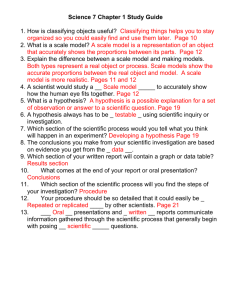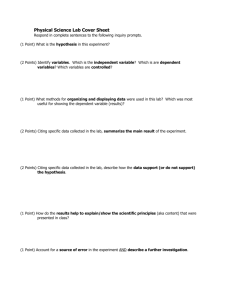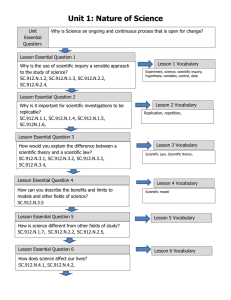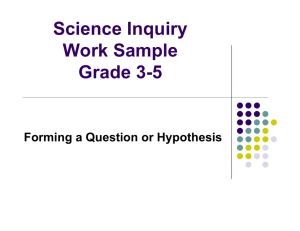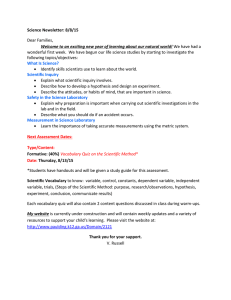3-5 Scientific Inquiry scaffolding
advertisement
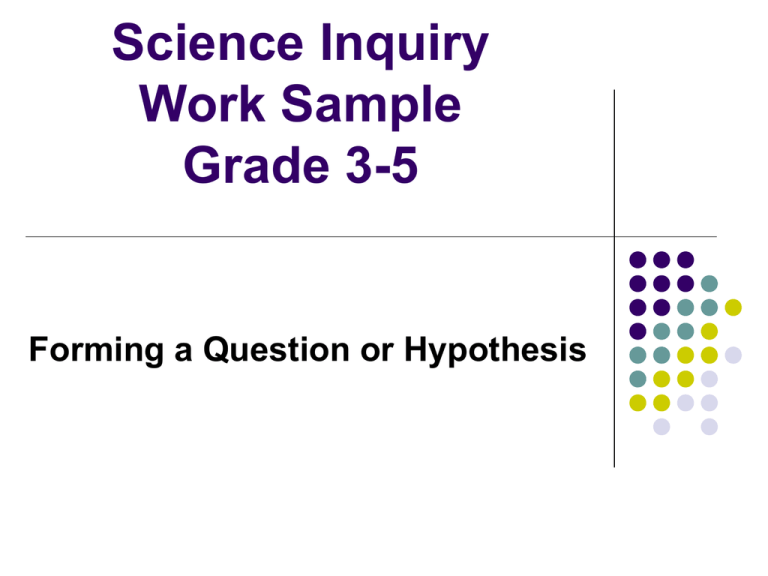
Science Inquiry Work Sample Grade 3-5 Forming a Question or Hypothesis Steps for Forming a Question or Hypothesis Background Knowledge Testable Question Forming a Hypothesis, Claim or Prediction Prior Knowledge What is it? It is the student’s prior knowledge which can include the following: What students have heard at home or school What students have read at home or in class What students have seen on TV in person What students have experienced at home or at school Background Knowledge It may also include the following at each grade level: 3rd grade Teacher provided content Previous personal experience Observation, exploration, demonstration, video 4th/5th grade – adds the following Research Literature read Expert groups Internet Testable Question What is it? • • • • • Good investigation questions are interesting. Am I interested in finding out the answer to this question. Good investigation questions are those I do not already know the answers to. Do I already know the answer to this question? Good investigation questions leads to a plan of action. (a plan for what I need to do to answer the question, including the evidence I need to collect. Is this question written in a way that clarifies what I need to do (observe, measure, change, ect.) to answer it. Good investigation questions are those that can be answered with available material. Will I be able to find the material I need to answer the question? Good investigation questions are those that can be completed in a reasonable amount of time. Will I have the time I need to answer the question? Science and Children December 2010 Testable Question Examples: • Would a house plant grow better in sandy soil or potting soil? • Are bulbs brighter in in a parallel circuit or series circuit? • What effect does weight have on the distance an object rolls using a ramp? • Which boils more quickly, warm water or cold water? Forming a Hypothesis, Claim or Prediction What is a hypothesis? • An informed prediction based on prior knowledge and previous experiences. • It is framed using ELD sentence frames for making prediction leading to a hypothesis. Examples: - I think that …. will be most effective because ... - If (I do this) , then I think (this will happen) because When forming a hypothesis the variables need to be identified. One of the variables is tested and the others are controlled. • Ex. Plant growth: The amount of sunlight, amount of water, type of soil, or nutrients added. Science Inquiry Work Sample Grade 3-5 Design an Investigation Design an Experiment Components of an effective experiment includes the following: A list of materials needed for the experiment Relevant tools Procedures – what, when, where and how of the experiment . Includes safe and ethical considerations. Design: Materials/Tools Equipment and tools needed to make measurements or used in the process (ex. thermometer, stopwatch, ) Materials used (Specific sizes and amounts) (ex. cups, water, Alka-Seltzer, food coloring) Explain proper use of measurement tools Safety tools – things you need to keep safe Explain appropriate use of safety tools (ex. goggles, hot pad) Design: Procedures Use words and pictures Describe the step-by-step procedures Draw a picture of the setup or steps Make a plan with procedures incorporating multiple trials or observations How often are measurements taken? What data will you collect – what can be measured? Describe a logical procedure for collecting appropriate data Make a plan with details so that others can reproduce it Science Inquiry Work Sample Grade 3-5 Collecting and Presenting Data Collecting Data Components of an effective data collection: Record measurements and observations carefully and correctly. (Include pictures, drawings, or sketches with captions) Include units in all measurements. Record the observations or measurements in a logical and organized form. Record all changes in your procedure during the experiment. Record any observations, ideas or other comments that you have while performing the experiment. Data Presentation The Presentation of The Data Should Include: Neat and organized tables, graphs, diagrams and/or charts. (Choose the most sensible way to present the data) An explanation of any calculations. The specific units of the measurements. (ex: meters, grams, degrees in Celsius, and seconds) Example Antibacterial lab Treatment Diameter of inhibited growth in dish # 1 (mm) Diameter of inhibited growth in dish # 2 (mm) Average diameter of inhibited growth (mm) Control (water) 4 6 5 Hand Sanitizer 8 12 10 Bleach 18 14 16 Kyolic (Garlic Tablets) 5 7 6 Example Antibacterial lab 16 14 12 10 Control Hand Sanitizer Bleach Kyolic 8 6 4 2 0 Average Inhibition Diameter (mm) Science Inquiry Work Sample Grade 3-5 Analyzing and Interpreting Results Summarize and Analyze Test Results The conclusion is based on the data. Tell whether or not the data supported the hypothesis, prediction or claim. Students should use their data to defend their conclusion. (Students may practice this by discussing experimental results with classmates) This will need to be scaffolded with a lot of support beforehand Scoring Guide Terminology Using data or observation to support a reasonable explanation of the results. States a conclusion which discusses some variables, errors, limitations, patterns in the data, or possible explanation of results. Clearly communicate the relationship of the results to the original question or hypothesis. Science Inquiry Work Sample Grade 3-5 Assessment and Feedback Dimension Lessons SCAFFOLDING IS CRITICAL Each dimension can be taught as a lesson in any unit of study. Vocabulary should be front loaded. Science process skills should be introduced and practiced before doing a work sample. Essential skills can be modeled in other parts of the day in other subject areas. Assessment Science inquiry can be used as a formative and summative assessment. It is important to give feedback whenever possible. Feedback needs to be related to only the scoring guide if students want to re-do their work sample. Science inquiry work samples showcase all essential skills.

